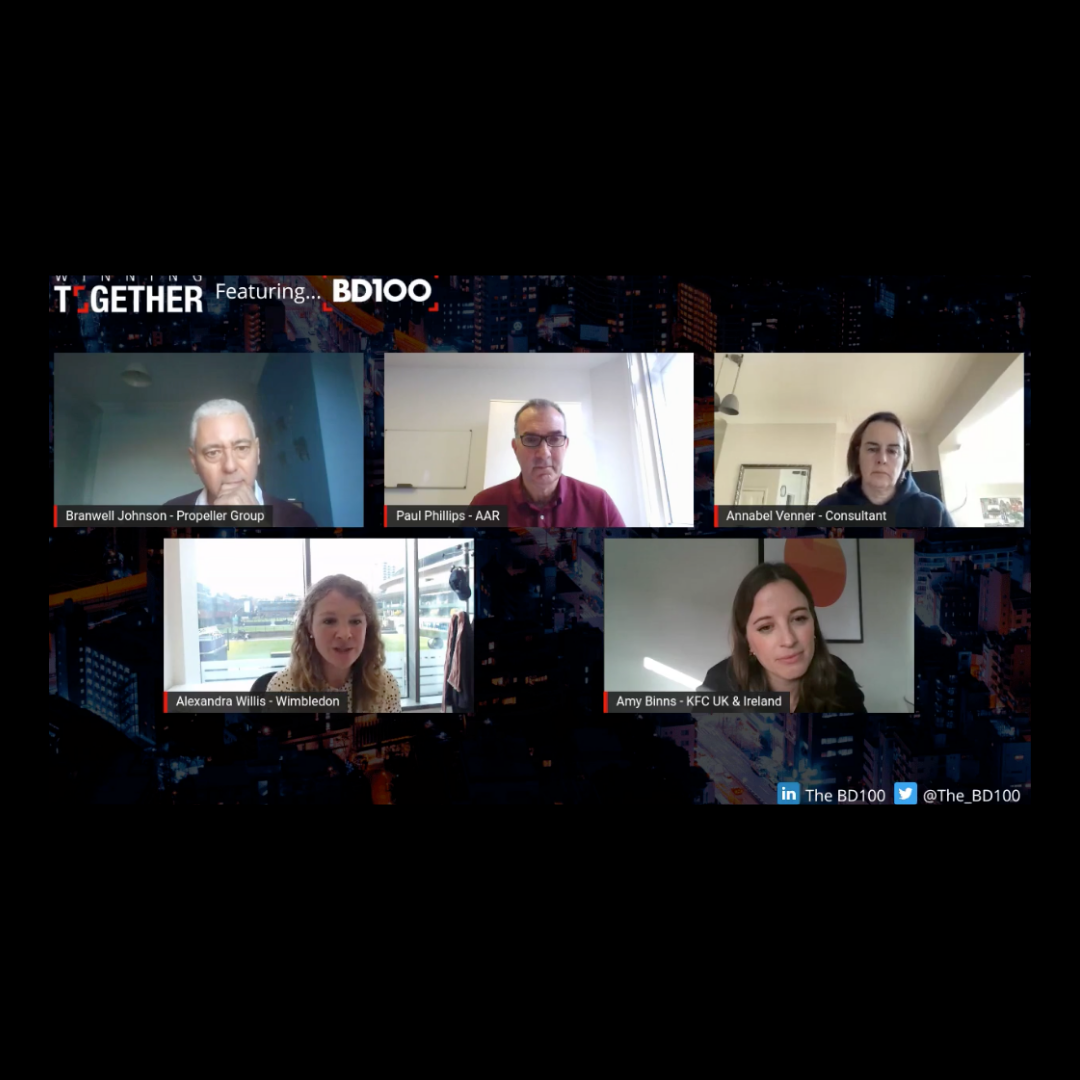
Agency marketing is one of the many challenges faced by new business and teams will already be planning for 2022.
Our recent Winning Together: BD100 panel Tough Truths for Agency New Business provided some honest feedback from brand-side clients on the best ways to get their attention.
Propeller Group’s Director of Content Branwell Johnson hosted the panel and was joined by Alexandra Willis, Communications and Marketing Director at Wimbledon, Amy Binns, Head of Brand KFC UK & Ireland, Annabel Venner, former CMO of Hiscox and a Chair of the Marketing Society Fellow and Paul Phillips, Managing Director of marketing consultancy AAR.
Getting on the radar
Marketers are time-poor with an ever-expanding remit – but the imperative is to ensure your agency is front of mind when they do start assembling a potential pitch list. Potential clients do expect a sophisticated and strategic approach Amy said: “The value of personal connections is clear. The long-term agency relationships we have are generally down to the people and connections we make.”
Annabel said: “I’ve overseen lots of pitches at Hiscox and Coca-Cola. Generally the agencies that we work with would come from recommendations from my network, as well as being celebrated in third party environments like the trade press.”
Amy added: “Having existing client testimonials really does grab attention – how you treat your current clients is probably the most important new business tool.”
Paul made the call for creativity in approach and stressed: “If I was a CMO, and received a cold call, it wouldn’t seem like a particularly creative way to engage me.”
Agencies should always be looking at how to cut-through and Annabel pointed out that a piece of physical collateral landing on the desk can make an impact – be it a book or a printed report. She also said that award wins can influence opinion.
Informal conversations are welcome but they must be at the right time – and this is often at events. Alex says: “There are definitely examples of informal conversations with agencies operating in a space we weren’t necessarily looking at, sparking ideas and encouraging us to move in that direction.”
Agencies shouldn’t expect instant results. Alex stressed: “It is important that these conversations aren’t in sales mode, it is about educating and building a relationship. It could be years before it gets to the pitch stage.”
Think strategically on social
Social media – especially LinkedIn – has an important role to help get you noticed. An interesting thought leadership article can be invaluable in grabbing attention and does not have to be category specific. Alex explained that the most impactful content presents itself as: “’This is the challenge we helped solve’. Most brands and businesses face the same challenges – so content which reflects the pressures of these audiences is the best way to encourage someone to stop scrolling and read.”
Amy pointed out she is more invested in people than brands, agencies and organisations, which means agencies should consider how to give a more personal touch to their content. “I follow people for their thoughts and experiences. Sharing thought leadership pieces on LinkedIn is a powerful way to tell personal stories. But equally content which is churned out and spammed quickly becomes ignored and fades into background.”
Paul stressed that what is most persuasive is dealing with a circumstance as opposed to a product or service. “For example, if you are a traditional business who is losing out to new, digital competitors – you want an agency who knows how to answer this challenge. How they can solve challenges is more important than brand knowledge – and even more important than category experience.”
Thought leadership pieces which involve the agency’s client are especially powerful, added Annabel. Their presence endorses the thinking or case study and will give it more traction for readers.
Size isn’t always a barrier
Big agencies have a lot of resources to call on to create and develop thought leadership content, craft other collateral and enter awards. They have high level contacts and extensive networks to lean into. But what of the smaller specialist or start-up agency?
Paul said it can be done but it takes sacrifice. “Any agency, regardless of size, can throw people, time and money at winning new business. If you focus your attention on a specific target audience, to the exclusion of most other opportunities, you will come across as more authentic. The BD approach which says, “we need an airline and fragrance brand”, is no good to anyone.”
Annabel agreed it was harder for smaller agencies to break through to brands like Coca-Cola where pitch processes can be big and slow. But big businesses can differ and at Hiscox they were receptive to small agencies. The best thing for an agency is to do the research and learn who does this brand work with, what does it do and who looks like someone we could work with within the organisation?
With the business landscape brightening up, it’s certainly a good time to put an honest lens on what works and what doesn’t in regard to BD outreach. As Alex said: “This isn’t a time to return to normality – this is an opportunity to redefine what normal is.”
Practical takeaways
- Do your research and be aware of what a brand is doing. Don’t chase if they have just appointed a new agency
- Look for positive reasons to engage – for example when a CMO speaks about approaching new areas
- Thought leadership that shows how to solve challenges is more important than brand knowledge